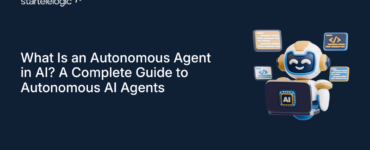As AI adoption surges in business, AI hallucinations in enterprise environments are becoming a serious issue. These occur when AI models generate content that’s fluent but factually wrong or entirely made up.
According to Gartner (2024), over 35% of companies using large language models (LLMs) have encountered hallucinated outputs, often leading to poor decisions, compliance risks, or loss of customer trust. McKinsey also reports that 60% of executives rank AI reliability as their top concern in enterprise deployments.
In high-stakes settings, these hallucinations can’t be ignored. Enterprises must prioritize mitigating AI hallucinations through robust AI risk management, content validation, and enterprise AI governance.
This article explores how to detect hallucinations, reduce AI errors, and build trustworthy AI for enterprises.
The Growing Challenge of AI Hallucinations in Enterprise
At its core, an AI hallucination happens when a model generates content that is fluent and confident—but factually incorrect or completely fabricated. It’s one thing when a chatbot tells a joke that doesn’t land. It’s entirely different when it gives false information about interest rates, return policies, or medical procedures.
In traditional human-led support, agents follow standard operating procedures (SOPs). They’re trained, coached, and monitored. Their performance is measured. There’s a chain of accountability.
So naturally, enterprise leaders ask:
“Can we trust AI to follow the same standards of consistency, accuracy, and control?”
Why Do AI Hallucinations Happen?
Understanding the root causes helps us build better defences. Here are the key reasons AI hallucinates:
1. Probability Over Truth
Language models generate the “most likely” next word — not the “most correct” one. They don’t understand truth; they mimic patterns based on their training.
For example, if asked a question that’s not covered in its context or retrieval source, the model will try to “fill the gap” with statistically likely but potentially incorrect text.
2. Lack of Grounding
If the model is not grounded in your real-time business data, it will default to what it “remembers” from training data. This may be outdated, irrelevant, or simply incorrect.
3. Ambiguous Prompts
When users provide vague or overly broad queries, the AI may try to “guess” the intent — leading to hallucinated content.
4. Overconfidence Bias
AI models tend to generate fluent, well-structured, and authoritative-sounding content — even when they’re wrong. This increases user trust in inaccurate outputs.
5. Lack of Validation or Oversight
Without proper monitoring, feedback, and validation tools in place, hallucinations go unnoticed — especially in high-volume environments.
1. Ground the AI in Trusted Enterprise Knowledge
The number one way to reduce hallucinations is by grounding the model’s responses in approved, real-time enterprise content. This means connecting your AI model to a curated, structured knowledge base or database.
This is typically done using Retrieval-Augmented Generation (RAG), where the model retrieves factual, relevant information from your sources before generating a response.
Benefits of Grounding:
- Ensures factual consistency
- Limits the AI to what it knows is correct
- Enables dynamic updates (e.g., new pricing, updated policies)
- Reduces reliance on the model’s internal (and often outdated) training
Real-world Example:
An AI assistant at a telecom company grounded in live plan data will never hallucinate a non-existent data package. Instead, it pulls current offers from the source of truth.
Action: Build a strong internal knowledge layer. Use APIs, vector databases, and content pipelines to keep it fresh and authoritative.
2. Build AI Content Validation Pipelines
AI responses must pass through validation layers, just like human agents go through QA.
Validation involves checking the output before it’s delivered — either automatically or via human review — to ensure it follows business logic, policy, tone, and factual correctness.
Methods of Validation:
- Automated checks for prohibited words, unsupported claims, or policy violations
- Cross-referencing output against databases or policy documents
- Confidence scoring to block or flag low-confidence responses
- Feedback tagging from customers and internal teams
Enterprise Benefit:
By validating outputs in real time, you minimize the chance of hallucinations slipping through — especially in sensitive interactions like legal claims, financial recommendations, or public communication.
Action: Integrate automated QA systems or human-in-the-loop layers where high precision is essential.
3. Establish Strong Enterprise AI Governance
Enterprise AI governance is the foundation of responsible AI deployment. It ensures that all use of AI is transparent, controlled, and aligned with company policies and values.
Key Components:
- Ownership: Define who owns the AI systems, training data, and outputs.
- Policy Frameworks: Create clear guidelines on where and how AI can be used.
- Approval Processes: Implement review gates for high-impact content.
- Version Control: Track which model version is used where — for compliance and audit trails.
Why It Matters:
Without governance, AI systems evolve ad hoc. This invites risk, inconsistency, and accountability gaps — especially when hallucinations lead to customer complaints or legal disputes.
Action: Form a governance council with IT, legal, product, and CX stakeholders to manage AI use holistically.
4. Monitor and Detect Hallucinations in Real Time
You can’t fix what you don’t see. Enterprises need systems to track, log, and detect hallucinated outputs — especially at scale.
Monitoring Strategies:
- Logging AI output and prompt history for transparency
- User feedback collection (e.g., thumbs down, “This isn’t correct”)
- Escalation tracking: How often do customers escalate from bot to human?
- Anomaly detection models that flag out-of-distribution or odd behavior
Why It Works:
Real-time detection allows your team to catch recurring issues, identify model blind spots, and take action — retrain, reconfigure, or reinforce — before damage spreads.
Action: Use observability tools tailored for LLMs, and track metrics like hallucination rate, fallback rate, and response accuracy.
5. Implement Human-in-the-Loop for High-Stakes Content
In areas where hallucinations can cause major harm — like law, healthcare, finance, or contracts — always pair AI generation with human oversight.
This doesn’t mean slowing everything down. It means using AI for speed and draft creation, but letting humans review, approve, and fine-tune the final output.
Best Use Cases:
- Drafting legal agreements or regulatory filings
- Preparing board reports or investor comms
- Responding to high-profile customer cases
- Creating public-facing policy statements
Enterprise Benefit:
This hybrid approach improves productivity while ensuring compliance, tone, and precision—especially in scenarios where 99.9% accuracy isn’t good enough.
Action: Set thresholds for confidence and sensitivity where human review becomes mandatory.
6. Train and Fine-Tune on High-Quality, Domain-Specific Data
Generic AI models are trained on general data. That’s great for average tasks, but not for enterprise-specific needs.
To reduce hallucinations, fine-tune your model with company-specific terminology, tone, and policies. Use clean, labeled, and up-to-date datasets from your own environment.
What to Include:
- Past tickets and customer interactions
- Knowledge base articles
- Internal wikis and product specs
- Legal and compliance documentation
Outcome:
The AI becomes more accurate, context-aware, and aligned with how your business actually operates. This drastically reduces the need for corrections or rewrites.
Action: Build internal datasets and retrain or fine-tune your LLM to match your domain.
Final Thoughts
AI in the enterprise isn’t just about automation — it’s about trust.
When we allow AI systems to interact with customers, assist employees, or influence decisions, we’re putting our brand, compliance, and reputation in their hands. That’s why hallucinations are not just a technical bug — they’re a business risk.
But the good news is: hallucinations are manageable.
With the right approach, enterprises can confidently use AI at scale without compromising on accuracy. The key is to:
- Control what the AI sees (ground it in reliable business data)
- Control what the AI says (through validation, prompts, and policies)
- Control how the AI behaves over time (using monitoring and governance)
AI doesn’t need to be perfect — it needs to be predictable, safe, and accountable. If you treat it with the same discipline you apply to human processes — training, rules, oversight, and review — it becomes a valuable and trusted part of your operation.
Enterprises that do this right will lead the way in trustworthy, scalable, and responsible AI adoption.
FAQs About AI Hallucinations in Enterprise
1. What exactly is an AI hallucination?
An AI hallucination happens when a model generates content that sounds correct but is actually false or made up. It may include incorrect facts, fake policies, or invented answers — often written in a very confident tone.
2. Why are hallucinations more dangerous in enterprise settings?
In business, inaccurate answers can lead to legal risks, customer dissatisfaction, revenue loss, or regulatory violations. Unlike casual use, enterprises operate at scale — so even small errors can have a big impact.
3. Can hallucinations be completely eliminated?
Not entirely — but they can be greatly reduced. Using tools like Retrieval-Augmented Generation (RAG), content validation, monitoring, and governance, you can catch and prevent most hallucinations before they reach users.
4. How can I detect if my AI is hallucinating?
You can detect hallucinations by:
- Logging and reviewing AI outputs
- Collecting user feedback (e.g., thumbs down, escalations)
- Using anomaly detection models
- Comparing answers to source content or databases
5. Should we allow AI to respond directly to customers?
It depends on the use case. For low-risk tasks, AI can respond autonomously. For complex, high-stakes issues (legal, medical, financial), it’s better to have human-in-the-loop workflows to ensure accuracy and compliance.
6. What’s the first step to make our AI safer?
Start by grounding your AI in your internal knowledge base. This alone reduces hallucinations drastically. From there, add validation tools, governance policies, and human oversight for sensitive areas.




